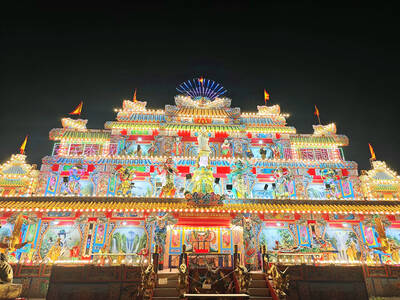This bilingual book on Taiwan’s birds is excellent for several reasons. Two of them, however, stand out. First, whenever a species is discussed, a captioned color photo of one of its members appears without fail on exactly the same page. Second, it contains a marvelous account of the history of bird conservation on the island — how matters progressed from casual but widespread netting, both for the pot and for the sale of caged specimens, to government-supported attempts at conservation.
Taiwan is a place where Western views are gradually replacing traditional Chinese ones. The traditional Taiwanese view of birds was that they were useful to eke out a sparse diet, and nice to have about the house for free musical entertainment. The modern, originally Western, view is that, despite our extensive dependence on captive animals for food, wild ones should be left free to do as they please, with the elimination of entire species being perceived as a very bad thing indeed.
Before reading this book I’d found guides to Taiwan’s birds in English a problem. One, The Complete Guide to Birds in Taiwan, for example, lists a mere 50 species, whereas the Birdwatcher’s Guide to the Taipei Region describes and illustrates 82. The truth is there are over 450 species found here, and The Swallows’ Return recommends A Birder’s Guide to Taiwan by Dave Sargent, published in 1998, complete with a checklist.
Kate Rogers begins by describing a bird-watching trip to Wulai, close to Taipei. As Rogers and her husband Derrick Wilby inspect the premises of a presumed bird trapper, one central issue immediately becomes clear. It’s illegal to trap wild birds in Taiwan, but small shops selling them are ubiquitous nonetheless. Law-enforcement, in other words, is of crucial importance.
From their house in the hills of Takeng (大坑), just outside Taichung, the couple is next described as driving to Anmashan (鞍馬山) in search of Swinhoe’s Pheasant, near-threatened globally, as well as the Taiwan Whistling Thrush and the Taiwan Hill Partridge. In a similarly precarious position is the Mikado Pheasant, pictured on Taiwan’s NT$1,000 bill. The Mikado is unique to Taiwan, and its appearance on the bank note is a sign of official conservation perspectives, even though Rogers mentions finding endless Internet sites describing Taiwan as “the worst importer of wild animal parts in Asia.”
Even so, things have improved hugely since the 1970s. In an exceptionally fascinating chapter entitled “Barbecued Brown Shrike,” Rogers describes the almost single-handed efforts of John Wu (吳森雄), author of the first comprehensive Chinese-language field guide to the birds of Taiwan, to change government policy on bird protection.
Rogers and Wilby met him in 2003 at the October gathering of bird-watchers in Kenting to observe the large raptors — Oriental Honey Buzzards, Grey-faced Buzzard Eagles, Chinese Goshawks — that congregate there, pausing to rest on their long migration south. The number of enthusiasts present are proof of changing attitudes, watching “large ‘kettles’ of raptors rising and swirling among massive cumulus clouds hanging over the glittering sea.”
After visiting the New York State branch of the Audubon Society in the US, Wu was made aware of the Taiwanese habit of barbecuing the Brown Shrike, as well as the capturing and exporting at that time of thousands of Grey-faced Buzzard Eagles a year, together with many other large-sized raptor species, to Japan. Eagles represented prosperity to the Japanese, he was told, and between 1976 and 1977 a staggering 60,000 Grey-faced Buzzard Eagles alone were captured and exported north to be slaughtered and stuffed.
But there were problems. Countries that were signatories to CITES (the Convention on International Trade in Endangered Species) would automatically have the powers, not to mention the obligation, to stop such a trade. But even Japan, with 15,000 bird-watchers in 1977 lobbying their government to join, wasn’t a signatory, let alone somewhere that China routinely tried to block from joining any international organization.
So Wu tried an indirect approach — a hallmark, some say, of Taiwanese life as a whole. In 1978 he helped Taiwan join the newly-formed East Asia Bird Conservation Union, and then arranged for their second annual gathering, in 1979, to take place here. He next invited the government to issue commemorative stamps and coins depicting birds. That achieved, he approached the police in the Kenting-Pingtung area and asked them to begin collecting illegal traps in advance of the Union’s Taiwan meeting. After encountering initial reluctance, he succeeded, and over 3,000 traps were burned in a public ceremony. In an inspired piece of face-saving, Wu invited the Chief of Police to light the fire.
Even more subtly, Wu then initiated a campaign to stop people eating the Brown Shrike. He collected photos that showed the dissected birds were full of parasitic worms, and had the pictures reproduced on posters in the area where the capture of the birds was most common.
Slowly traditional habits began to change. When Wu’s magisterial Chinese-language field guide was published in 1994, it sold out within four months. Currently he’s working to discourage fruit-farmers using “mist nets” to protect their produce. Such fine-mesh nets entangle and then cause the deaths of many small birds such as Nuthatches and Pygmy Woodpeckers.
There is much more in this excellent book, including surveys of high-profile species such as the Black-faced Spoonbill and the Fairy Pitta, the latter specifically championed by now-president Chen Shui-bian (陳水扁) in 1998. Not all the news is good — current government re-structuring may pose a threat to conservation areas and nature reserves, for instance. But the bird-watching ball is rolling in Taiwan, and this book is both a record of its history and a description of the experiences of two of its recent practitioners.
To buy this book, go to www.govbooks.com.tw.

Jan. 5 to Jan. 11 Of the more than 3,000km of sugar railway that once criss-crossed central and southern Taiwan, just 16.1km remain in operation today. By the time Dafydd Fell began photographing the network in earnest in 1994, it was already well past its heyday. The system had been significantly cut back, leaving behind abandoned stations, rusting rolling stock and crumbling facilities. This reduction continued during the five years of his documentation, adding urgency to his task. As passenger services had already ceased by then, Fell had to wait for the sugarcane harvest season each year, which typically ran from

It’s a good thing that 2025 is over. Yes, I fully expect we will look back on the year with nostalgia, once we have experienced this year and 2027. Traditionally at New Years much discourse is devoted to discussing what happened the previous year. Let’s have a look at what didn’t happen. Many bad things did not happen. The People’s Republic of China (PRC) did not attack Taiwan. We didn’t have a massive, destructive earthquake or drought. We didn’t have a major human pandemic. No widespread unemployment or other destructive social events. Nothing serious was done about Taiwan’s swelling birth rate catastrophe.

Words of the Year are not just interesting, they are telling. They are language and attitude barometers that measure what a country sees as important. The trending vocabulary around AI last year reveals a stark divergence in what each society notices and responds to the technological shift. For the Anglosphere it’s fatigue. For China it’s ambition. For Taiwan, it’s pragmatic vigilance. In Taiwan’s annual “representative character” vote, “recall” (罷) took the top spot with over 15,000 votes, followed closely by “scam” (詐). While “recall” speaks to the island’s partisan deadlock — a year defined by legislative recall campaigns and a public exhausted

In the 2010s, the Communist Party of China (CCP) began cracking down on Christian churches. Media reports said at the time that various versions of Protestant Christianity were likely the fastest growing religions in the People’s Republic of China (PRC). The crackdown was part of a campaign that in turn was part of a larger movement to bring religion under party control. For the Protestant churches, “the government’s aim has been to force all churches into the state-controlled organization,” according to a 2023 article in Christianity Today. That piece was centered on Wang Yi (王怡), the fiery, charismatic pastor of the